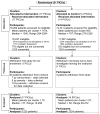Protocolized sedation vs usual care in pediatric patients mechanically ventilated for acute respiratory failure: a randomized clinical trial
- PMID: 25602358
- PMCID: PMC4955566
- DOI: 10.1001/jama.2014.18399
Protocolized sedation vs usual care in pediatric patients mechanically ventilated for acute respiratory failure: a randomized clinical trial
Abstract
Importance: Protocolized sedation improves clinical outcomes in critically ill adults, but its effect in children is unknown.
Objective: To determine whether critically ill children managed with a nurse-implemented, goal-directed sedation protocol experience fewer days of mechanical ventilation than patients receiving usual care.
Design, setting, and participants: Cluster randomized trial conducted in 31 US pediatric intensive care units (PICUs). A total of 2449 children (mean age, 4.7 years; range, 2 weeks to 17 years) mechanically ventilated for acute respiratory failure were enrolled in 2009-2013 and followed up until 72 hours after opioids were discontinued, 28 days, or hospital discharge.
Intervention: Intervention PICUs (17 sites; n = 1225 patients) used a protocol that included targeted sedation, arousal assessments, extubation readiness testing, sedation adjustment every 8 hours, and sedation weaning. Control PICUs (14 sites; n = 1224 patients) managed sedation per usual care.
Main outcomes and measures: The primary outcome was duration of mechanical ventilation. Secondary outcomes included time to recovery from acute respiratory failure, duration of weaning from mechanical ventilation, neurological testing, PICU and hospital lengths of stay, in-hospital mortality, sedation-related adverse events, measures of sedative exposure (wakefulness, pain, and agitation), and occurrence of iatrogenic withdrawal.
Results: Duration of mechanical ventilation was not different between the 2 groups (intervention: median, 6.5 [IQR, 4.1-11.2] days; control: median, 6.5 [IQR, 3.7-12.1] days). Sedation-related adverse events including inadequate pain and sedation management, clinically significant iatrogenic withdrawal, and unplanned endotracheal tube/invasive line removal were not significantly different between the 2 groups. Intervention patients experienced more postextubation stridor (7% vs 4%; P = .03) and fewer stage 2 or worse immobility-related pressure ulcers (<1% vs 2%; P = .001). In exploratory analyses, intervention patients had fewer days of opioid administration (median, 9 [IQR, 5-15] days vs 10 [IQR, 4-21] days; P = .01), were exposed to fewer sedative classes (median, 2 [IQR, 2-3] classes vs 3 [IQR, 2-4] classes; P < .001), and were more often awake and calm while intubated (median, 86% [IQR, 67%-100%] of days vs 75% [IQR, 50%-100%] of days; P = .004) than control patients, respectively; however, intervention patients had more days with any report of a pain score ≥ 4 (median, 50% [IQR, 27%-67%] of days vs 23% [IQR, 0%-46%] of days; P < .001) and any report of agitation (median, 60% [IQR, 33%-80%] vs 40% [IQR, 13%-67%]; P = .003), respectively.
Conclusions and relevance: Among children undergoing mechanical ventilation for acute respiratory failure, the use of a sedation protocol compared with usual care did not reduce the duration of mechanical ventilation. Exploratory analyses of secondary outcomes suggest a complex relationship among wakefulness, pain, and agitation.
Trial registration: clinicaltrials.gov Identifier: NCT00814099.
Figures
Comment in
-
Protocolized sedation in critically ill children.JAMA. 2015 Jan 27;313(4):363-4. doi: 10.1001/jama.2015.1. JAMA. 2015. PMID: 25602195 No abstract available.
-
Sedation protocol for critically ill pediatric patients.JAMA. 2015 May 5;313(17):1754. doi: 10.1001/jama.2015.3459. JAMA. 2015. PMID: 25942730 No abstract available.
-
Sedation protocol for critically ill pediatric patients--reply.JAMA. 2015 May 5;313(17):1754-5. doi: 10.1001/jama.2015.3462. JAMA. 2015. PMID: 25942731 No abstract available.
References
-
- Randolph AG, Wypij D, Venkataraman ST, et al. Effect of mechanical ventilator weaning protocols on respiratory outcomes in infants and children: A randomized controlled trial. JAMA. 2002;288(20):2561–2568. - PubMed
-
- Tobias JD. Tolerance, withdrawal, and physical dependency after long-term sedation and analgesia of children in the pediatric intensive care unit. Crit Care Med. 2000;28(6):2122–2132. - PubMed
-
- Reade MC, Finfer S. Sedation and delirium in the intensive care unit. N Engl J Med. 2014;370(5):444–454. - PubMed
Publication types
MeSH terms
Substances
Associated data
Grants and funding
LinkOut - more resources
Full Text Sources
Other Literature Sources
Medical
Molecular Biology Databases



